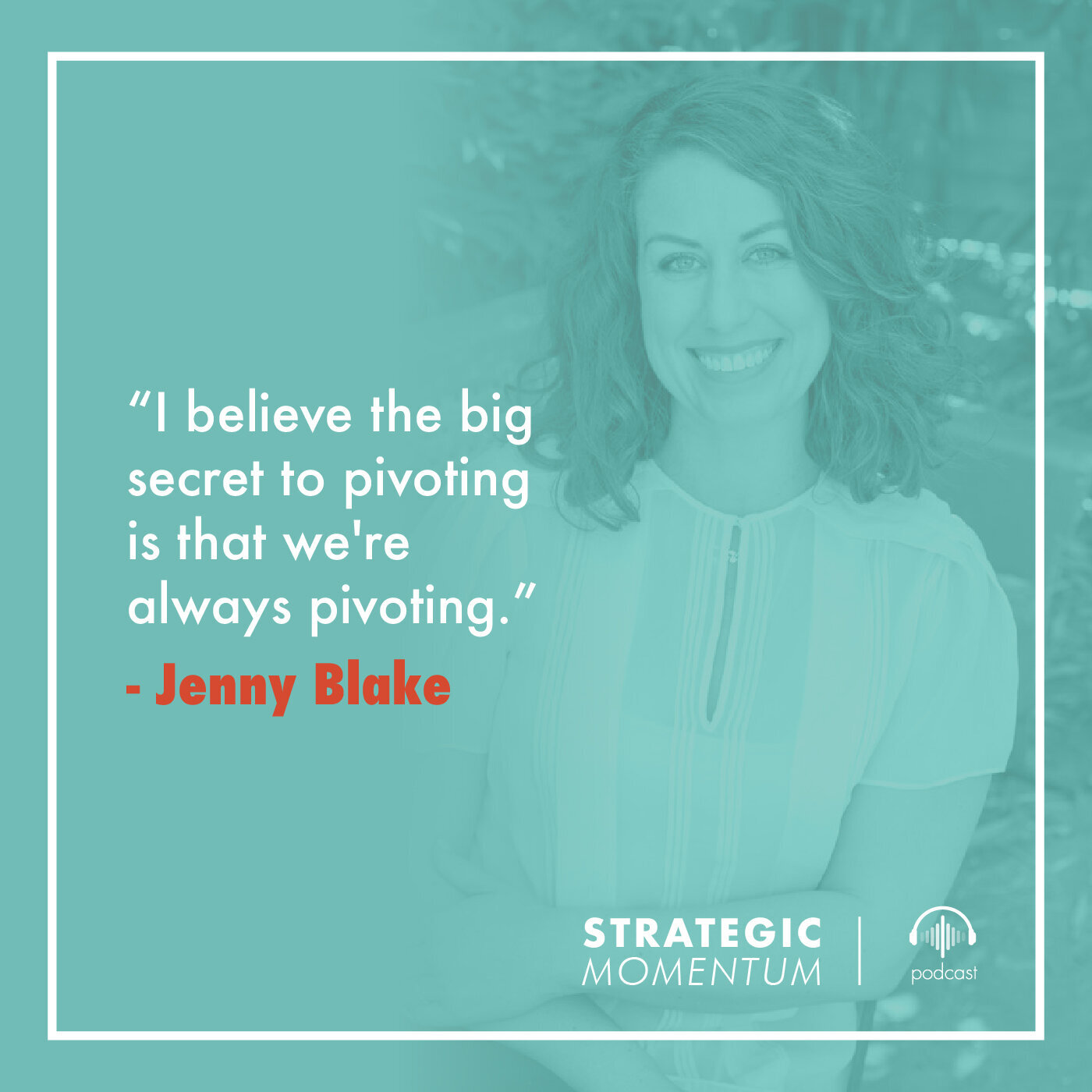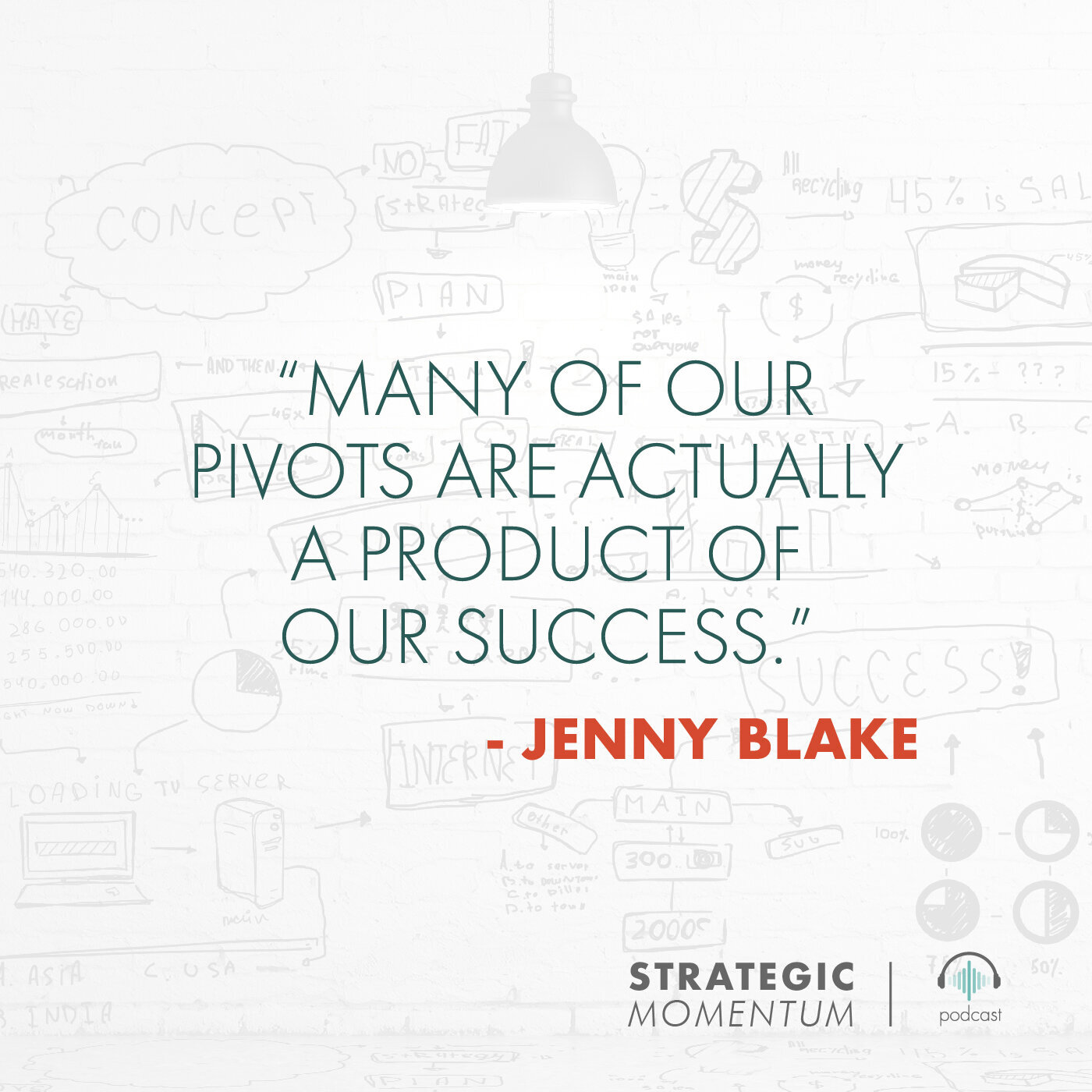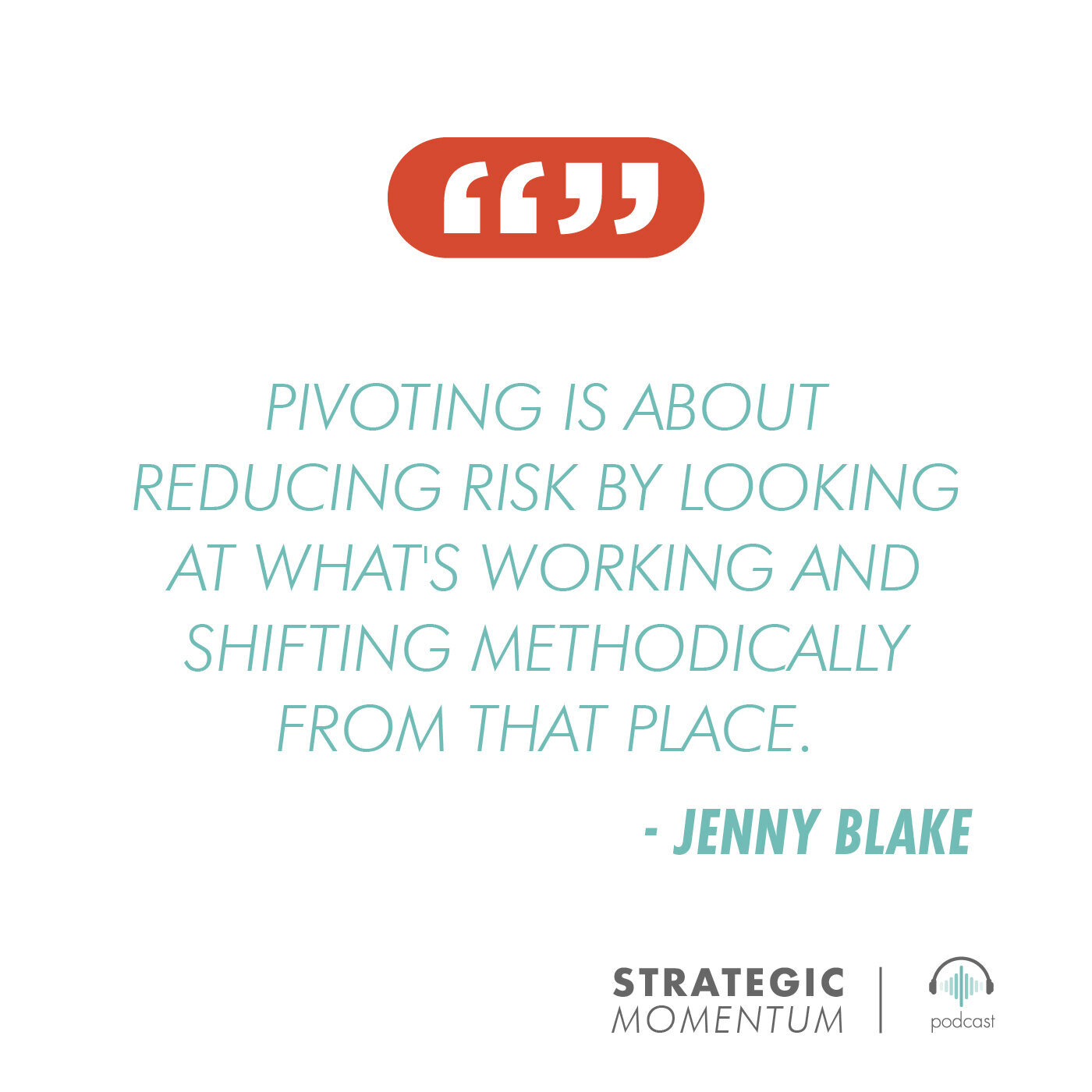Ep. 76 - Career Pivoting: Starting Small and Methodically Shifting to Create Momentum - with Jenny Blake
Find Us Wherever You Listen To Podcasts
As we begin Season 4, we face a work landscape that has been drastically altered by the coronavirus pandemic. We’ve had to change how we work on a macro and micro level, and many people have also had to seek new jobs in new industries, changing the type of work they perform. In fact, this shift is so prevalent that 2020 has been deemed the year of the pivot by The New York Times.
More people than ever are asking the question, “What’s next?”
Pre-COVID-19, a pivot occured when a worker hit a career plateau, usually, but pivoting has now become a necessity for countless people. With that in mind, our first podcourse of this season is with Jenny Blake, a career and business strategist, international speaker, and the author of “Pivot,” a step-by-step method to help you map what's next. It’s a strengths-based approach that emphasizes doubling down on what is already working to shift into a new, related direction.
Jenny has pivoted many times, from studying political science, communications, and computer science at UCLA to becoming the first employee at a start-up in Silicon Valley. She later worked at Google, where she spent over five years in Training and Career Development as the company skyrocketed from 6,000 to 36,000 employees, while also writing her first book, “Life After College.” Jenny left Google in 2011 to take her consulting business full-time.
In this episode, she shares her strategies, advice, and insights on pivoting, which are more important than ever.
In this episode she shares:
Her experience with pivoting multiple times throughout her career and how it led her to where she is today
The challenges and mindset needed to make a change
The approach to creating the traction that will move your career in the right direction
Pivoting to Find Professional Purpose
Early in her working life, Jenny struggled to find her way and also assumed she was at fault for this:
“Most of my career felt like fumbling through the dark... feeling like I was having some kind of crisis every time I hit what I now would call a pivot point, and feeling always that the problem was me.”
As the first employee at a Silicon Valley startup while she was in college, she struggled with feelings of confusion and loneliness as she attempted to navigate the ‘real world’ - a topic that became her first website, Life After College, and a book of the same name.
From the startup, Jenny moved to Google, working in Training and Career Development at a time of rapid growth for the tech company. Despite working for an industry leader in a role that would be seen as the dream job for many, she found herself hitting a plateau, unfulfilled and looking for more. This brought on feelings of self-doubt and self-blame.
“When I hit plateaus or pivot points, I often felt that there was something wrong with me, that I must be one of those entitled millennials that the media keeps talking about. Why can't I just be happy, especially at this big, fancy brand and dream job?”
Yet despite those feelings, Jenny took action. She chose to pivot from perceived stability to self-employment and pursue a full-time business based “Life After College.” She chose to bet on herself, self-doubt and all.
“And after five-and-a-half years at Google in coaching and career development, I pivoted to self-employment, not thinking I was at all cut out for it but just knowing I would regret it if I didn't at least try.”
So, how did Jenny drive her career forward out of this place of uncertainty to where she is now? In two ways:
Number 1 is to stop taking pivots personally. Too often, we get caught up in the negative, on what we don’t want, instead of focusing on the enjoyable parts of a role and the skills we do have. Careers are modular and we should be aware of the various moving parts that are defining our current situation.
Number 2 is to stop waiting for things to be perfect. At Google in particular, she learned to take a good idea and run with it. Even if it is not successful, the idea can be iterated upon. The same is true in your own career. It is important to take what you have and see where it leads, testing and learning along the way.
What is a Career… and a Career Pivot?
For Jenny, the word ‘career’ is stodgy like the word résumé, which is a documentation of your past and what you moved on from. The reality is that it’s much more modular today, and the metaphor she likes to use is the smartphone — those apps that reflect the skills, education, experience, side hustles, hobbies that work for you.
And what people want out of a career has evolved as well. For Jenny, “career is really about ... the work, passions, purpose, and activities that you're doing that bring you joy, that allow you to feel like you're contributing positively and that will evolve as you do.”
To find that alignment, it’s about methodically shifting in a new direction by doubling down on what’s already working. It’s not a big leap or going all-in with no data or experience in that direction, which is risky.
Pivoting should not be seen as a sign of failure, but rather as a sign of success. Those who hit a career plateau want more. They want to see change and growth. It is a Fear of Not Trying, instead of a Fear of Missing Out. Jenny terms this group of workers as Impactors:
“If you're an impactor and you're in a role where you've stopped learning and growing, there's almost no amount of money that can keep you there. You will start to become increasingly more miserable. And boredom, studies show, can be as actively uncomfortable and manifest in the body the same way that stress does.“
So what is a practical way to facilitate a successful pivot that’s not only grounded in a strategic understanding of your strengths and interests but also a vision of where you want to be?
The 4 Stages of the Pivot Method: Plant, Scan, Pilot and Launch
Pivoting does not need to be a sudden move or snap decision. In fact, this is a misconception that limits many people from gaining the right traction and momentum.
“A big mistake I see a lot of people make is trying to figure out what to do first, and not basing that in a really deep understanding of their strengths and what does success look like a year from now.”
Instead of aimlessly taking action, workers should first “plant.”
The Plant Stage is all about grounding yourself and building a foundation to work from. Take note of what’s working, what you would like to do more of, and where you want to go. It requires some creative thinking and reflection. Map out your values, your strengths, and your goals.
In any pivot, there will be a gap between where you are and where you want to be. It’s crucial to have the mindset that it’s okay to not know and to embrace challenges, as the learning opportunity is important.
That’s where you’ll be able to grow from a zone of unconscious incompetence to a place of conscious competence. Only then are you ready to scan.
The Scan Phase is about building the framework to bridge where you are now and, generally, where you want to be. It’s structured exploration — researching what you may want to do and identifying ways to fill in those gaps of knowledge and skills.
But it also entails meeting with others who can offer insights and perspectives, which will help clarify the types of opportunities that interest you most. Part of this process is building that network of people who can help get you there.
And while ‘networking’ can have negative connotations, we often already have friends or co-workers who we can learn from, and who may even have contacts that could help you through your journey.
Remember, it is important for this to be a two-way street. Networking should be seen as building a village. Through this village you can learn, grow and make yourself discoverable. And by approaching this process unselfishly, your village will be with you as you take the next step in a pivot: the pilot.
The Pilot Stage is where you try things in order to figure out what’s next. You’re testing those ideas you believe can help you get to your vision and doing it in a scrappy way. This is where Jenny talks about “not waiting for things to be perfect.”
You’re taking smart small risks — not big bets — to eventually inform bigger decisions on what’s next. And a good pilot will help you understand those three E’s Jenny mentioned: Do I enjoy this area? Can I become an expert at it? And is there room to expand?
The Launch Stage is when one of your pilots takes off. It’s where you make the decision to commit to one of your experiments and go all-in, and it essentially completes your pivot. Jenny explains that there are two types of launches:
“There's the big L Launch where you go all in on a new direction. And then, there's a little L launch, which is just as a result of working through the first three stages, plant, scan, pilot, what's one little thing that you can do next? I also had someone point out to me that, sometimes, a launch is saying no.”
The launch is built upon the three stages before it, each of which reduce risk, and committing despite any remaining uncertainty. The secret to pivoting is that we’re always pivoting, and building skills, experiences and relationships along the way will help you launch any future pivots you may choose to take.
Key Takeaways
Pivoting isn’t personal. It is a constant in one’s career and it is our response to it that defines our future.
Pivoting is about reducing risk by looking at what's working and shifting methodically from that place.
The most successful pivot starts right where you are. You can pivot within the role that you have, within your own business, and if you're self-employed, how you structure your client engagements.
Impactors seek to not only learn and grow but also impact.
These are individuals who are willing to bootstrap a business, make a lateral move or move horizontally within your organization, or take on a side project or volunteer work outside of “your career” that is very rewarding and fulfilling.
A pivot is not a sign of failure, but often comes because of success. It means that you've succeeded at the role that you had or the set of projects that you had and, now, you're looking for greater growth, bigger stretch and impact.
The goal is to find some next step that's in your stretch zone, not your panic zone. Stretch is where you should be aiming for where you feel it's edgy and exciting and, yet, we are challenging ourselves out of the comfort zone.
One of the biggest mistakes that people make is thinking they have to make a big bet or take a huge chance when they pivot. If you want to pivot strategically, reducing risk along the way, you have to first understand your strengths and start from there.
Focus on what you want and what is working, rather than getting stuck on what isn’t working.
It is crucial to find the North Star of what success looks like for you before determining your options. Ask yourself questions about your future:
What does success look like a year from now?
How much do you want to be earning?
Who do you want to be surrounded by?
What kind of projects would you love to be working on?
How do you want to learn and grow?
What kind of impact do you want to make?
Pivoting requires creative thinking and self-awareness. There are 4 steps in a successful pivot:
Plant: Identify and harness your strengths. Commit to what is working and set a clear vision.
Scan: Explore your options. Bridge the gap between where you are and where you want to be through people, skills, and opportunities.
Pilot: Test new ideas and reduce risk by learning from these iterations.
Launch: Take one of your pilots to the next level by committing to it.
For any pivot or anytime that you are pivoting, there's a gap between where you are now and where you want to end up.
Be scrappy — don’t wait for things to be perfect before deciding to pivot and remember there is no way you can know whether you're cut out for something until you try.
It's not go big or go home, it's go tiny. What's the tiniest place you can start gaining some traction and momentum, which will help build your confidence?
There is no real way to know how long a pivot will take. So focus on what success looks like and what it takes to feel a sense of momentum and traction. And of course take into account your financial runway from a pragmatic sense.












